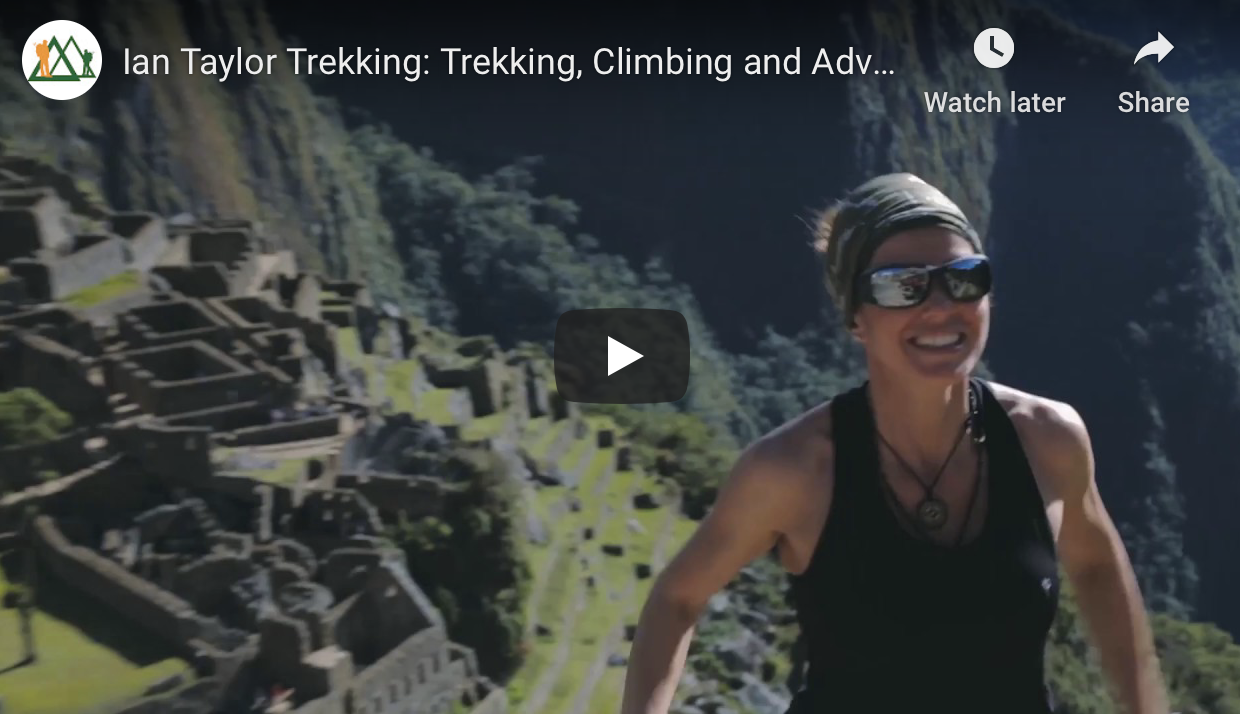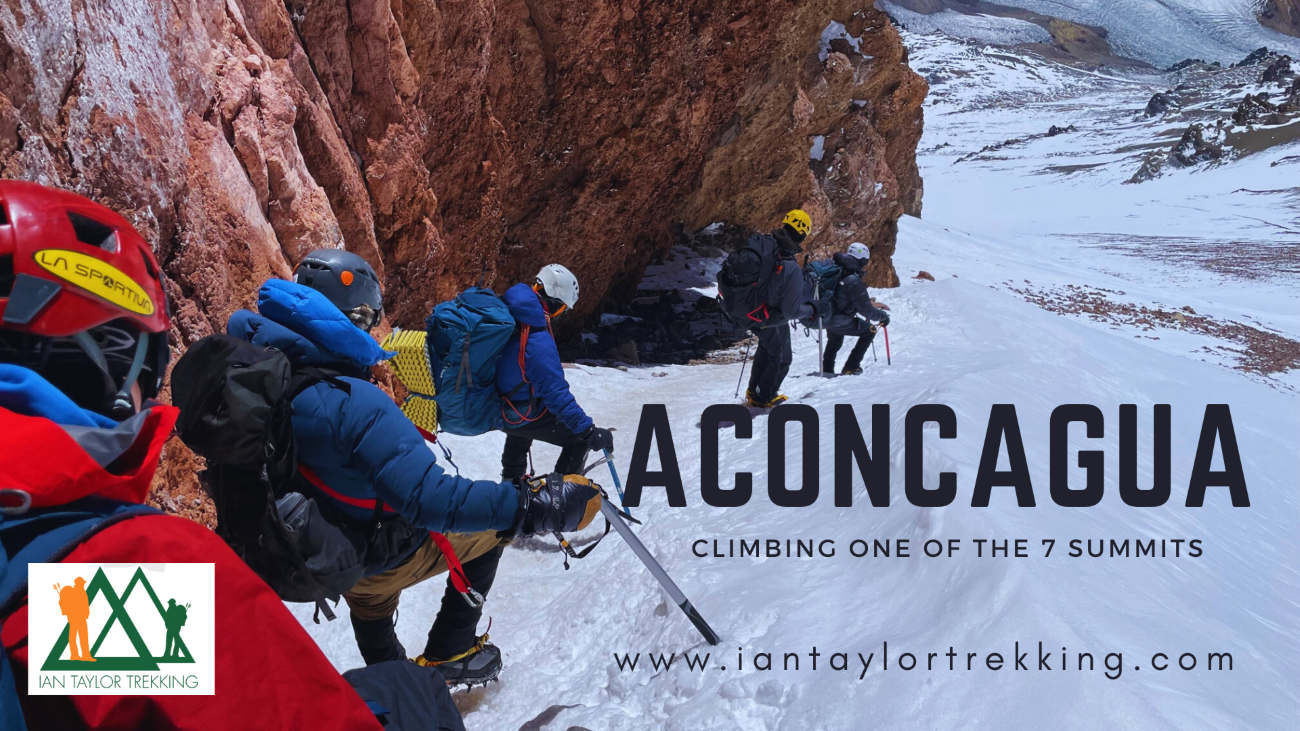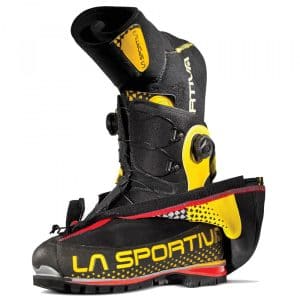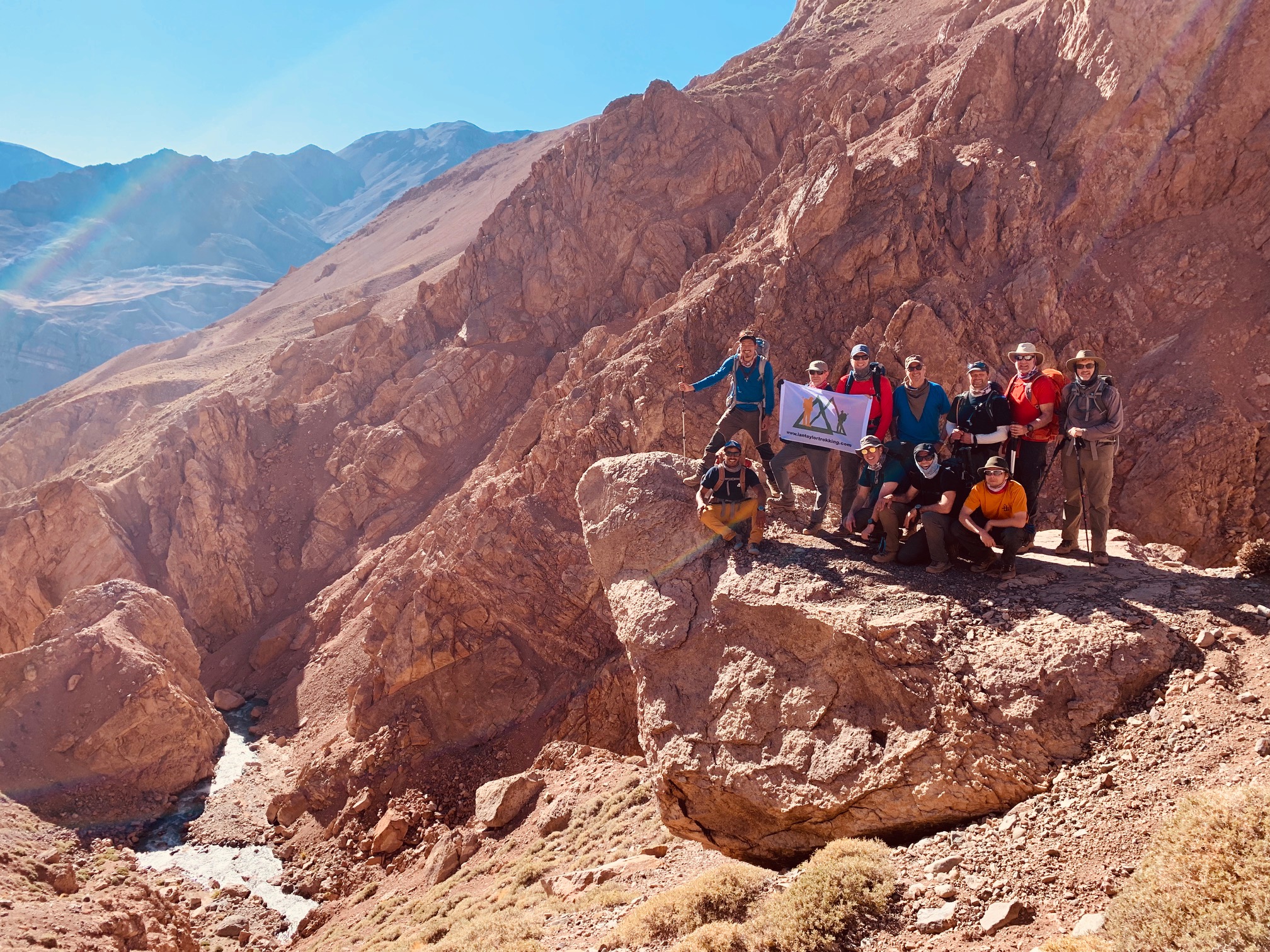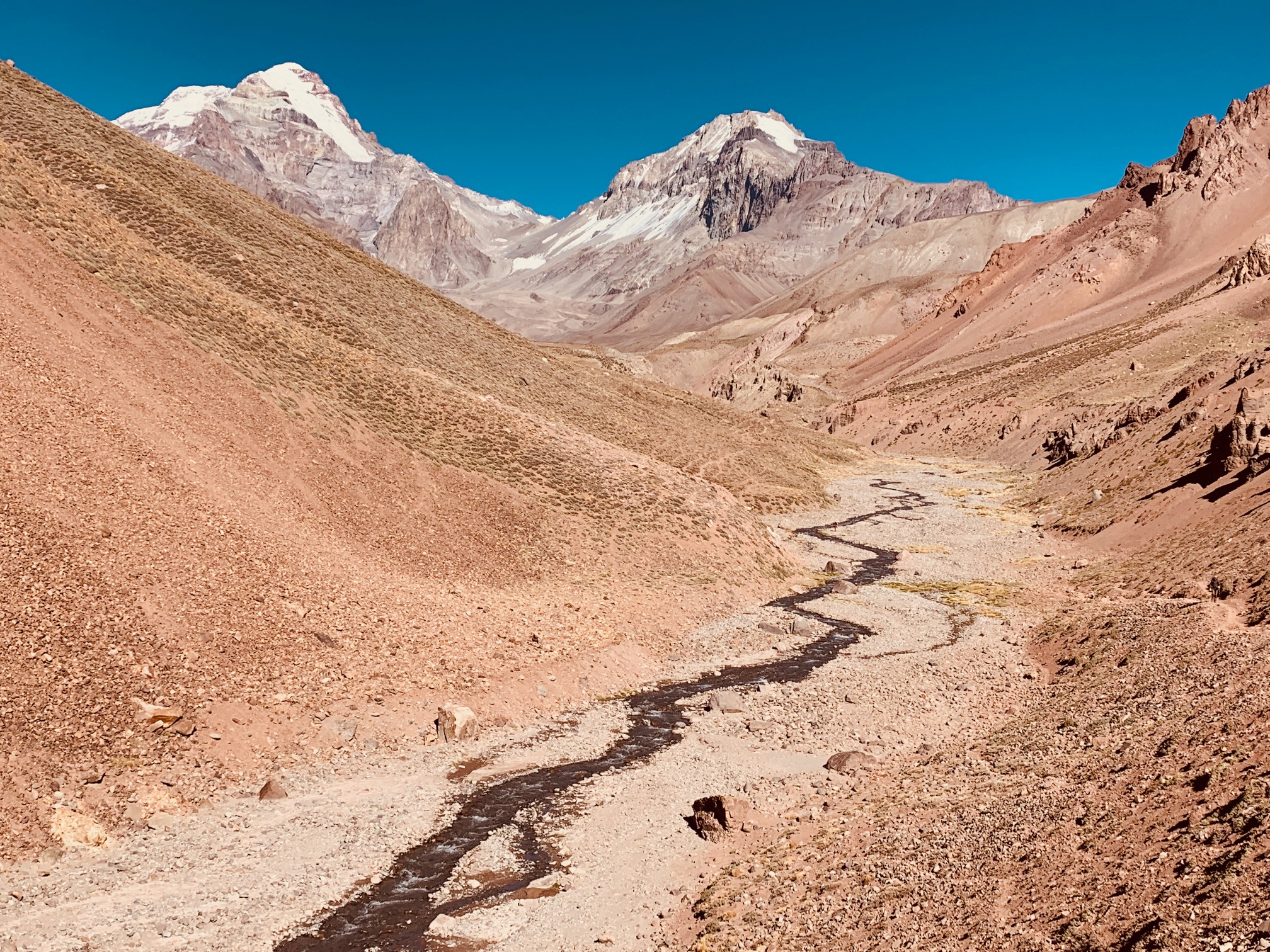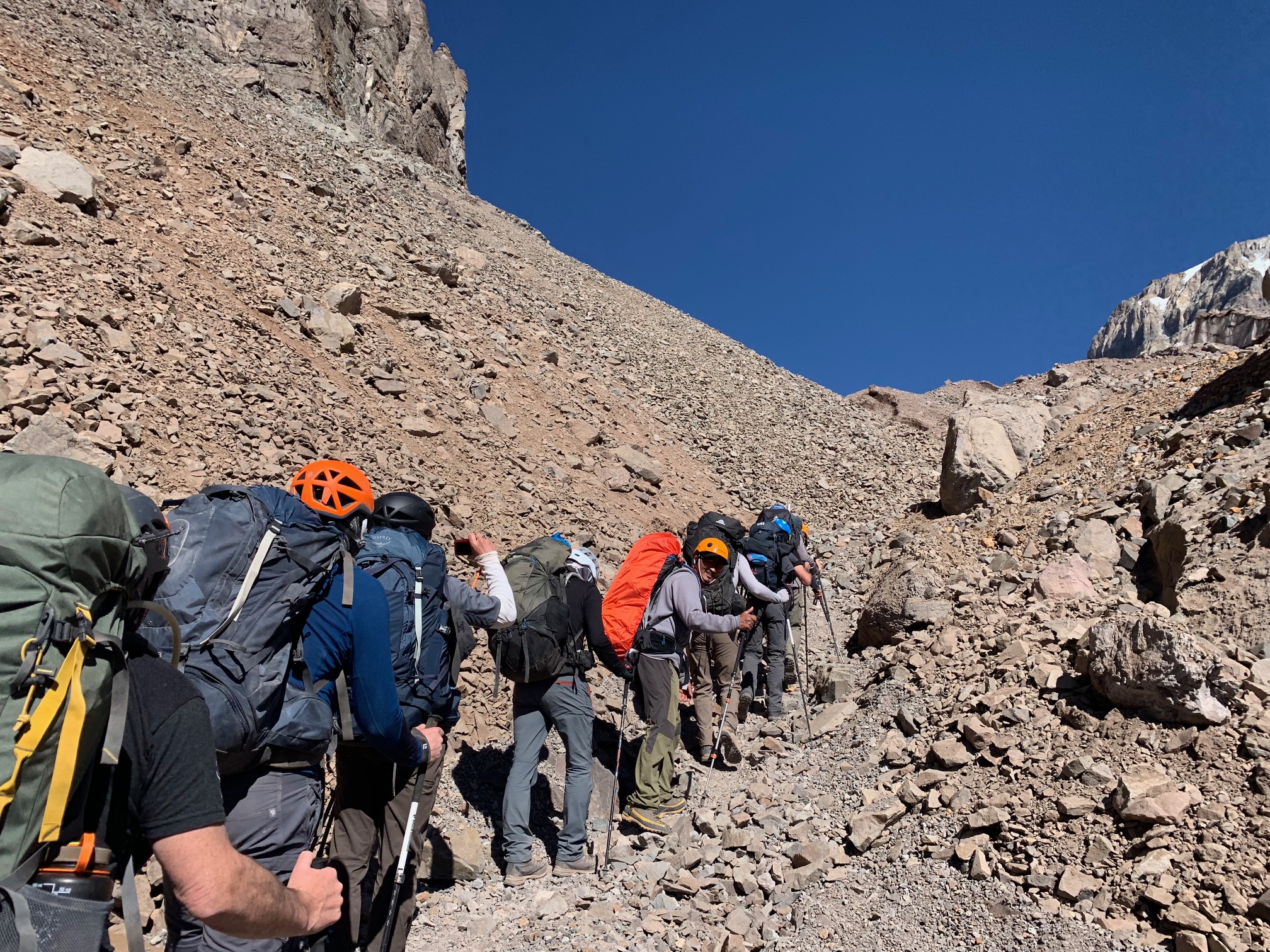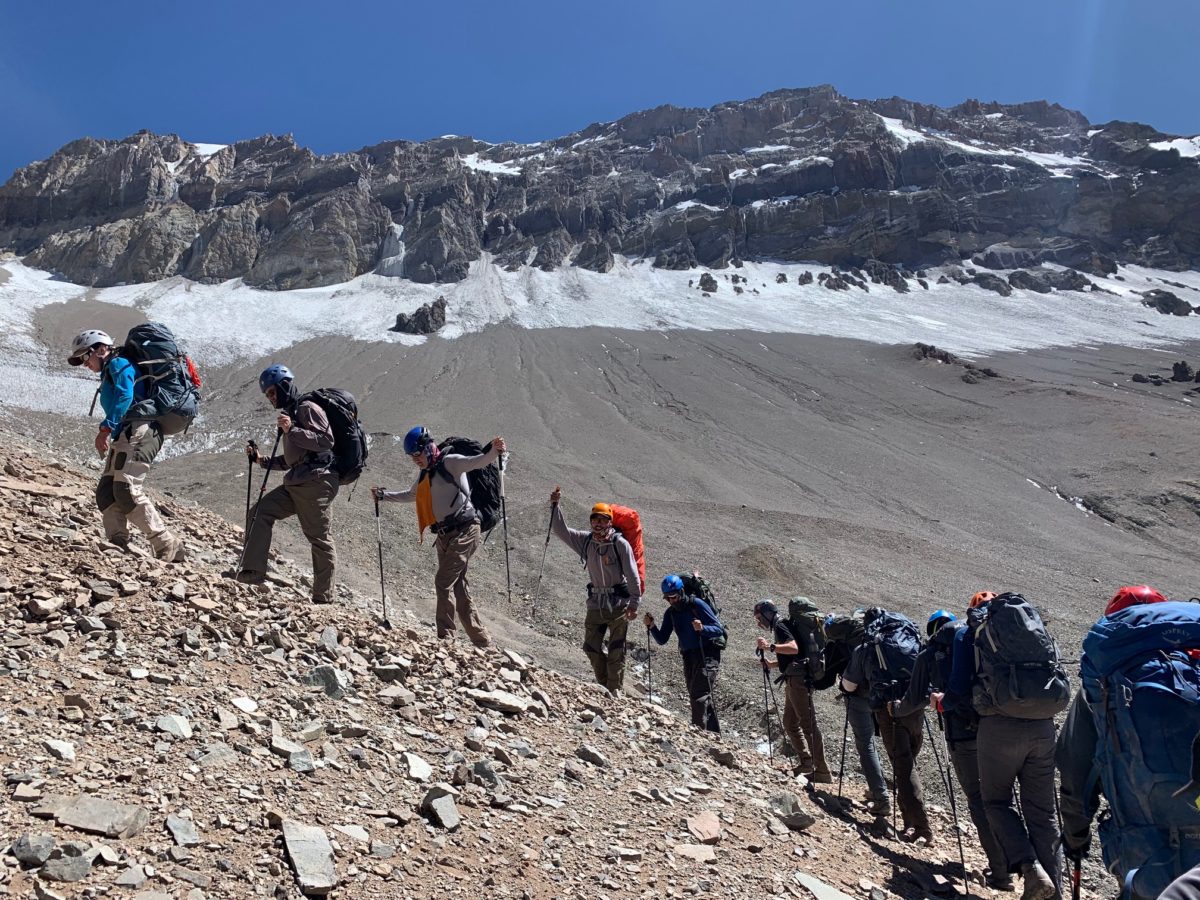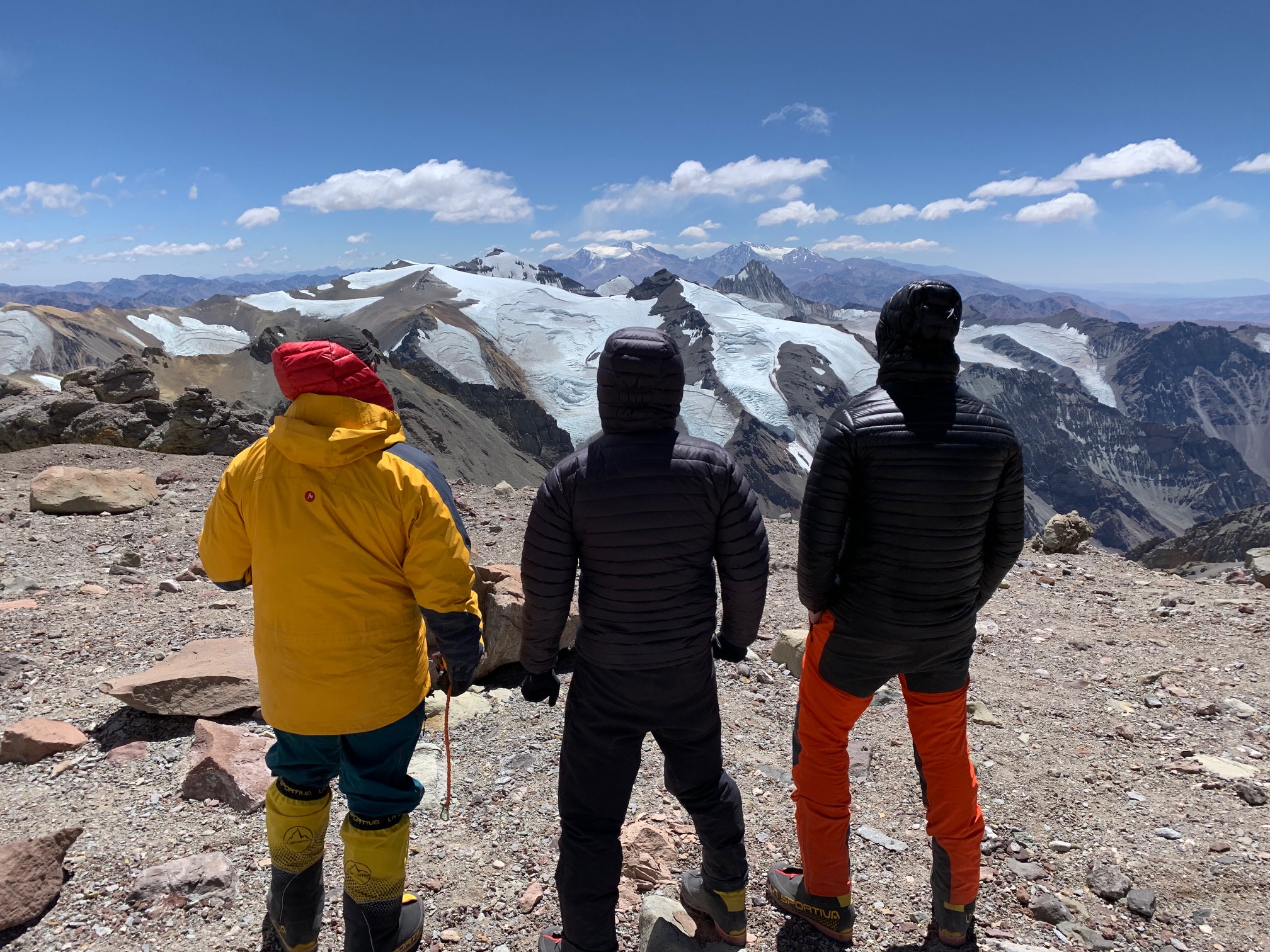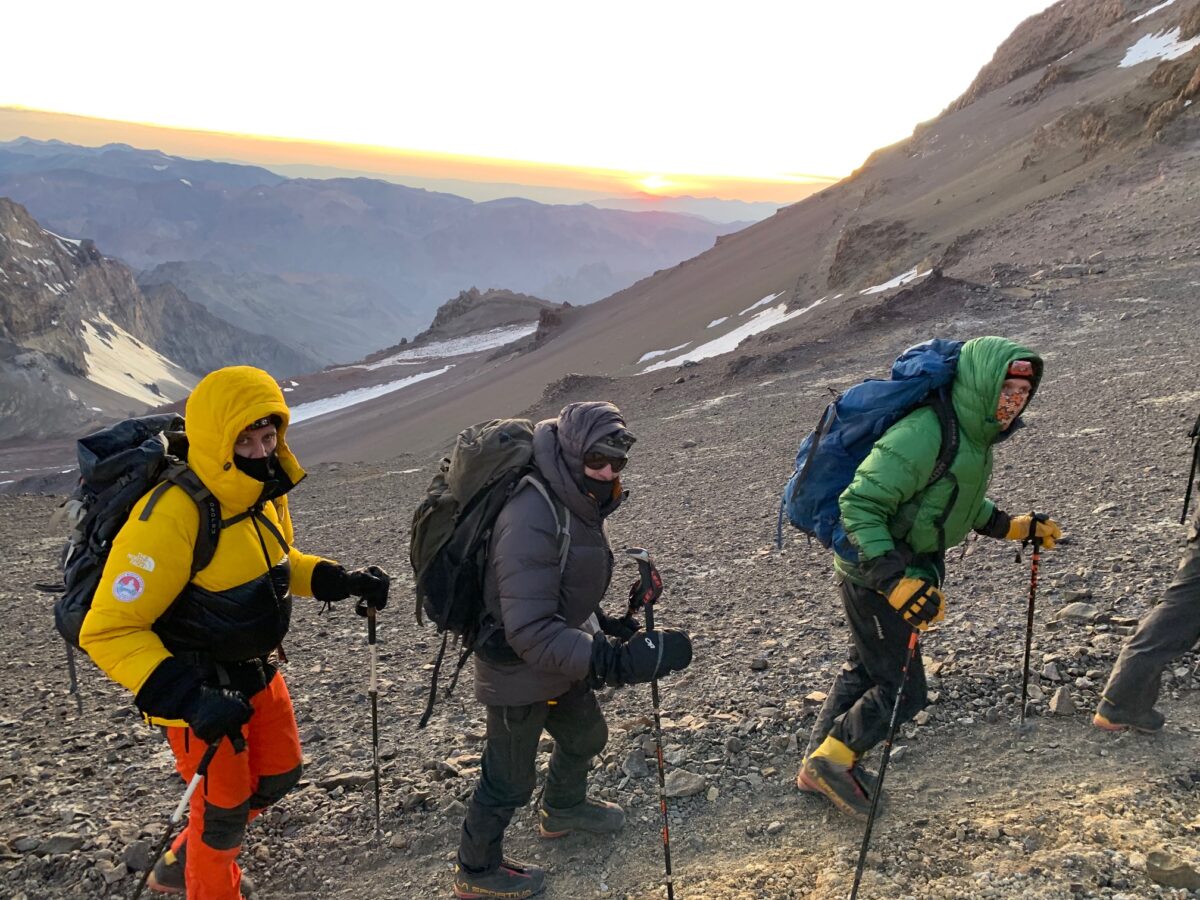Aconcagua The Vacas Valley Route
Our itinerary has 4 days when we can make a summit attempt. This alternative traverse route up Aconcagua is visually more stunning and a beautiful trail to complete this Aconcagua circuit trip. The cost is $5,950.
Tips and Advice
We have been running premium level trips to Aconcagua since 2010. We work with a highly qualified local team with major logistics in place so we can offer you the best possible service. Read some REVIEWS from our trips.
1). Highly Experienced Guides
Our mountain guides are qualified professionals of the Argentinean Association of Mountain Guides and school of High Mountain and Trekking Guides. The last qualification is a result of 3 years of Studying.
All of our guides hold professional mountaineering qualifications and wilderness First Aid Certificates. They are able to get you the help you need in case of an emergency. Also, our guides have continuous access to Base Camp and Head Office. We want to make sure all of our teams have the best chance at safely reaching their goal. With more guides with your team, they will be able to more efficiently manage your safety on the mountain and also give you a better experience along the way.
2). Expert Training Advice
We offer personal service with training advice for our clients, 5 days a week. A lot of people underestimate the physical preparation needed for Aconcagua.
We want to make sure that you have the best information on how to complete this adventure safely and successfully. There are some long 8+ hour days, with over 1,000m/ 3,280 feet of up and down hills on steep terrain while on the trail and mountain. Learn more about physical preparation.
3). Climb with an Everest Summiteer
Why not sign up to one of the trips that Ian personally leads. You can climb Aconcagua with someone who not only has reached the top of Mount Everest! but who has been on 7 Aconcagua Expeditions. Ian usually leads one Aconcagua trip every other year with 14 spaces open. You will need to book far enough in advance for these trips. Sign up and get access to Ian today.
4). 20 Years of High Altitude Experience at Your Service
We have years of experience managing teams on the ground in Argentina and around the world. Ian has led over 150 expeditions above 17,000 feet. Our head guides have been at the forefront of setting the standard on Aconcagua for the last 20 years. Our team is well connected on the ground with access to all the key organization and authorities. All our other guides are highly qualified in a range of mountaineering disciplines. We always have 1 guide for every 3/4 clients high on the mountain.
5). Quality Hotel, Service, Tents, Food and Equipment
In Mendoza we use the Diplomat Hotel. This hotel is centrally located. On the mountain we mostly use North Face VE 25 tents or Mountain Hardwear tents. These tents are tried and tested at high and extreme altitude. They have plenty of space for two people and the highest quality tents for mountain travel. We do have the option for a single tent for an additional fee for the trek in and Base Camp portion of this trip. For Safety reasons we like to have two people to a tent high on the mountain.
We have chefs in both Base Camps serving high quality food daily. There is access to showers, Wi-Fi, fruit, tea’s and snacks throughout the day. You can also charge phones and batteries in our dining tent.
6). Our Itinerary
Feel free to review our Aconcagua Itinerary and we are happy to explain why we prefer the Vacas Valley route over the boring normal route for climbing Aconcagua. The Vacas valley offers a more interesting trek into Aconcagua. There are less people on this side of the mountain and traversing the mountain is far more interesting for our groups. Camp 1 and Camp 2 are in more beautiful setting than anything on the normal route up Aconcagua. It is more expensive but worth it to have less people or more interested scenery.
7). All Inclusive Packages
We will pick you up from the airport and bring you to the Diplomat Hotel in Mendoza. Our staff will collect your permit fee and process the permit so you do not have to go and wait at the permitting office. All transport will be in high quality private vehicles. All of our trips include four nights when you can make a summit attempt. This is important to give the team the best chance at the summit.
On the mountain we service two course meals each day on the mountain. Therefore, you do not have to worry about bringing extra food. We have professional chefs in Base Camp on either side of the mountain. We can guarantee quality food throughout the trek because we fury fresh food into our campsites and Base Camps.
9). Small Group Sizes
We only work with small group sizes. The maximum number of people per team will be 12 people. Some of our groups are even less people with only 6 or 8 team members. We also run private groups to Aconcagua. This will therefore give you are more personalized experience on Aconcagua. We recommend this trip in the shoulder season as there can be too many people on the mountain.
10). Work with the Experts
Climbing Aconcagua is no easy task and you need the team, support and experience with you and behind you prior to your trip and on the mountain. Contact us for more information on our unique itinerary that we have tried and tested over many years. Read some REVIEWS and book early to secure your space on this trip of a lifetime!
1). Have Previous Altitude Experience
Having previous altitude experience is imperative when planning an attempt on Aconcagua. We believe that everyone should have 6,000m/ 19,685 feet experience, before attempting a peak like Aconcagua. You need to be as self-sufficient as possible and be used to carrying your own gear, on long, multiday hikes. If you are not hiring a porter to carry some or all of your gear, we recommend that you have experience with hiking at altitude with weight before taking on this challenge. We are available to talk with you directly to make sure that Aconcagua is the right choice for you.
2). Do Not Underestimate Your Training
Can you carry a 25kg/ 55lbs pack for 4 to 6 hours at sea level? Do not underestimate the training needed to be safe and successful climbing Aconcagua. Follow a regular training regime. If you are not using porters high on the mountain, then you should be comfortable carrying a 20kg/ 44Lb pack for 1,000m/ 3,000 feet in 5 hours, several days in a row. We highly recommend finding a Hypoxic training facility and using a machine 3 weeks before the trip. Creating red blood cells is key for success on Aconcagua.
3). Acclimatization is Very Important
Make sure you have adequate acclimatization built into your trip. We have additional days available on the mountain, to give you the best chance at safely reaching the summit. Make sure that you choose an itinerary that gives your body the necessary time to acclimatize lower down on the mountain, at the critical acclimatization points. Acclimatization is a critical component for safety and success on any high and extreme altitude expedition.
4). Bring Lightweight Equipment
On any Aconcagua expedition, you have to make numerous ascents up and down the mountain. One reason for this is to help the body adjust to the lower levels of oxygen. You also have to carry team equipment, along with your own personal gear. Check out our packing video. We send an itemized kit list on signing up.
5). Get a VO2 Max Test
Schedule a physical with your doctor to make sure you are in good health before you start training. You should then consider getting a VO2 MAX test or fitness test. The results should indicate your current level of fitness and provide a road map for the way ahead. Use the results to develop a proper training plan, so you are not guessing how your fitness is developing. You need to know at what heart rate your body produces lactic acid in your muscles. Training in the right heart rate zone and building the right training is important for your safety and success.
6). Understand Altitude Sickness
If you have been on a number of altitude expeditions with us you will know all about altitude related issues and problems. You should be up to date with statistics. Did you know around 30% of people make it to the summit of Aconcagua. Read and understand the principles of acclimatization and altitude illness.
7). You Should Consider Taking Diamox
If you are taking prescription drugs, make sure you bring a sufficient supply to last more than the length of your trip. We highly recommend taking Diamox for the duration of the trip. Our high altitude specialist doctor recommends 125mg in the morning and 125mg in the afternoon. Make sure your Diamox is in tablet form. You will also need to bring a number of antibiotics. There are alternatives to taking Diamox and you most certainly should bring ibuprofen on this trip.
8). Be Upfront With Your Medical History
Make sure your guides and trekking staff are informed of any previous conditions or medical situation you may have. Don’t keep any issues to yourself, altitude sickness can kill. We implement a slow pace for all trekking and acclimatization days on the trip, however, you can still have altitude related issues. Make sure that your guide knows your medical history.
9). Take Your Time in the Early Stage of the Trip
The pace of your trip is critical to recovery each day. Moving too quickly at altitude often leads to altitude illness and does not aid in your recovery. Fatigue is not your friend on a multi day trekking expedition. Good recovery is critical for a safe and successful trip.
10). Hydration, Hydration, Hydration
One of the most important tips we will give you is to make hydration a priority. Hydration in the dry desert of Aconcagua is extremely important. When you wake up you need to drink 1 liter of water before breakfast. You need to drink 2 liters before lunch and another 1 to 2 liters in the early afternoon. Using a water bladder system is ideal because you can then drip feed water into your body on a regular basis. This will be used on the trek in and lower on the mountain, however during the summit attempt it can not be used as it will freeze. Forcing water in, is not a good idea as you will just pee it out. You will need hyper hydration sachets, multi-vitamins and electrolytes while on the trip.
11). Separate all Your Gear into Dry Packs
Manage your gear well and keep all items separated in dry packs. Alternatively, you can keep your clothes in plastic bags. While you are on the mountain you will need to manage your gear in the tent correctly. Having a good tent routine is very important, keeping separate bags for gear is very useful. The dry bags are useful to keep your gear organized when you do gear drops up the mountain.
12). Make Sure you Eat as Much as Possible
We always have quality food on our trips and this is critical to your expedition. Sometimes at altitude, your appetite can dwindle, but you need to try and finish every meal. It will give you the strength and energy for each day on the trip. You do not want to over pack snacks as you have to carry everything up and down the mountain. You should have some recovery and protein bars in your duffel bag, which is carried by mules up to Base Camp. After that you will want to limit the amounts you carry on the mountain. Lightweight is best and snacks can be heavy.
13). Bring a Lightweight Air Mattress and Sleeping Bag
Remember above Aconcagua Base Camp, you will have to carry all your gear up the mountain. Make sure all your gear is as light as possible. You need to have a lightweight air mattress and warm sleeping bag. We recommend a Marmot Col -20F sleeping bag or similar on Aconcagua. You spend a lot of time in the your tent on the mountain, so you need to be comfortable throughout the whole trip. Sleep is a key ingredient to acclimatization and essential for success. Also, make sure that you have tested out your sleeping pad and bag out in the elements, so that you are comfortable with the set-up.
14). Work With your Teammates
Working as a unit and team is important in achieving the groups goals. Communicate with the guides if you are having problems. They can only help if they know that you are struggling. Aconcagua requires you to be a team player and maintaining a positive mental attitude at all times throughout the expedition. Encourage others and others will encourage you. We are much stronger as a group, not as individuals.
15). Bring Multi-Vitamins
We recommend taking multi-vitamins on a daily basis before and during the trip. These can either be the type that we dissolve in our water or as a tablet to take daily. You need to consider a range of supplements to maintain a strong immune system. Aconcagua is a dry high desert, so bring hydration tablets for your water to take daily. If you sign up with Ian Taylor Trekking for your Aconcagua expedition, we will send you a trip Dossier, that includes a complete kit-list for the trip.
16). Only Bring Essentials
Have a small medical kit that is easy accessible while climbing. This medical kit should have Ibuprofen, blisters plasters, tape, sunscreen, lip protection, medication, plasters and personal items. Also, make sure you have your personal medication you take with you at all times. You need to streamline your medical kit, in the same way you would on any trekking and mountaineering trips. Bring lightweight clothing and lightweight camping utensils.
17). Come With the Correct Mental Training
Having the experience of sleeping in a tent, in harsh weather conditions, will be essential in your preparations. Also carry a weighted backpack in your training, in order to be physically ready for the summit. Mentally prepared for your Aconcagua experience, for example, pushing the limit in your training sessions helps. Additionally, the more comfortable you are in a mountain environment, the more mentally prepared you will be. Staying positive with a good mental attitude on the mountain, is important for you and the people around you. Aconcagua is a mental and physical challenge. Staying positive in the face of harsh, challenging conditions is needed to be successful. Mental preparation starts at home in the hard training you do before the climb.
18). Expect Harsh Weather Conditions
Be ready to cope with diverse weather conditions. You may experience drastic changes in the weather from warm/dry conditions to freezing and windy weather. Some days you may have temperatures lower down on the trek that are 18C (65F) and sunny to -18C (0F) in the tent at camp 3 at 6,000m/ 19,685 feet. Likewise, on the summit night, you may experience temperatures as cold as -30C (-22F). High winds are usually the biggest challenge on Aconcagua, similarly freezing temperatures can cause you pain and discomfort. Understanding that some factors are beyond your control, and weather being a big one of these. Focus on the elements of the trip you can control, for instance you can come with the right attitude, gear and physical preparation.
19). Hit the Wall in Your Training
Know your limit on any mountain. One of the ways to achieve this is to hit the wall in your training at home. Remember your safety and the safety of others should be your number one concern on the mountain. Make sure that you have pushed yourself hard in your training and have prepared correctly before stepping foot onto the mountain. While you are on Aconcagua, don’t push yourself to the point of putting your life or the life of others in danger.
20). Respect Your Team and the Mountain
Respect your team and other climbers. You are climbing as a part of a team and therefore, you have to be aware that timelines have to be kept and differences have to be accepted. An expedition can be a multicultural experience with people joining our trips from all over the world. That means different cultural backgrounds with different religious ideals or philosophies. Everyone in your expedition is struggling to reach the same goal, so respect the team. If you see your team member struggling on any given day, be there to help them. It could be you the next day that needs the extra support! Team work and relaxed attitude will be valuable assets on a trip like this, finally respect the mountain and extreme altitude.
How Hard is it to Climb Aconcagua
I am sure you may have read Aconcagua is just a high altitude trek. This maybe true if you are in peak fitness and everything goes your way on the day. I can tell you from a wide range of experiences that the weather can be challenge every day on this expedition. You can experience intense heat, bitter cold, driving snow that create some of the harshest conditions you can experience on a mountain. High altitude, cold temperatures, rock fall and the risk of serious altitude sickness should temper anyone who things Aconcagua is a walk in the park. Make sure you can set up your own tent, sleep in a tent, and managing tent life in challenging conditions.
Acclimatization and Spare Days
Every expedition to high and extreme altitude needs specific acclimatization. Aconcagua also requires at least four days when you can make a summit attempt. On my last expedition we had to make a summit attempt a day early. The weather forecast was showing four days of bad weather during our planned summit attempt.
The first time I went to Aconcagua we were on the summit on day twelve. It was way to fast and it was a terrible experience. The guide was moving too fast and made for a terrible experience and lessons learned.
You need to take your time for your body to adjust to the low levels of oxygen. Acclimatization is everything on Aconcagua. As you go higher, the barometric pressure decreases, although the air still contains 21% oxygen, every breath contains less molecules of oxygen.
Physical Preparation
Aconcagua requires excellent physical preparation. We are available to help our clients understand the physical demands on climbing at high and extreme altitude. Learn more and get in touch with us directly as we can help you develop a training plans that will work for you. From experience the best way to prepare will be hiking up and down hills building from 500m/ 1,640 feet to 1,500m/ 5,000 feet over the course of months.
Daily training sessions our a must in supporting your longer weekly training session or hike. You should consider using the Stairmaster and develop a weight training plan. Strength building and endurance will be your core training. The Stairmaster carrying weight, building up to being comfortable carrying 20kg/ 44lbs will be important. You will need to carry different weights in different training sessions and we can help you develop this plan.
Weather
The weather on Aconcagua is unpredictable and challenging at the best of times. The success rate on Aconcagua is around 40% of people make the summit. There are many factors like lack of physical preparation, acclimatization but the weather, specifically high wind are the reason the success rate is so low.
Aconcagua is only 80 miles from the Pacific ocean, leading to extremely high winds and storms, similar to Denali in Alaska. The wind chills can drop well below zero in Fahrenheit in the better climbing months. This is why you need more contingency days for your expedition.
Prior Altitude Experience
Having specific conditioning and altitude experience from years of high altitude trips will only help you on Aconcagua. If you are thinking of climbing Aconcagua we recommend going on a number of high altitude trips prior to signing up to an Aconcagua trip.
Learning more about how you respond to low oxygen environments is critical for your safety on this mountain. You should consider, Everest Base Camp Trek, Kilimanjaro, Mount Elbrus, Island or Mera Peak. Everyone acclimatizes differently and it is important for you to understand how your body reacts in low oxygen environments. The more experience you have the better prepared you will be.
Other Important Information
We are big fans of the Vacas Valley traverse. There are advantages to trekking the normal route up Aconcagua. The hike into Base Camp on the normal route covers less distances than the Vacas route. Base Camp on the normal route is Plaza de Mulas 4,390m/ 14,402 feet and a little high than Base Camp on the Vacas side at 4,200m/ 13,780 feet. This means you will have less elevation gain on the normal route up to Camp 3 at 6,000m/ 19,685 feet. You will also carry no group equipment on the Normal route.
Portage of All equipment
You will be carrying everything yourself above Base Camp. Mules carry all equipment and your duffel bag and Expedition backpack into Base Camp. There is an option for support higher on the mountain for an additional fee. There are two options you can pay for a porter to carry 10kg of your personal gear or porter to carry up to 20kg of your personal gear and your portion of Expedition kit. We have porters based in both base camps ready to help with load carry’s. It is always best to book this support well in advance.
How Dangerous is Aconcagua
Aconcagua can be dangerous if precautions are not taken. The route we take has some rock fall risk above Base Camp below camp 1. There is also the risk of rock fall below and in the Canaleta high on the mountain. However, there are always deaths on Aconcagua each season. People getting caught out in storms, falling from fatigue, rock fall and high altitude related challenges will kill, if not managed correctly. The week before our last climb a lady died when she was struck by a rock high on the mountain.
There are a lot of rescues every season for altitude, frostbite and injured climbers. It is your responsibility to make sure you come in excellent physical condition and ready for all eventualities. However, it is the weather and altitude that makes Aconcagua dangerous.
Learn more about treatment for Altitude Sickness
Please familiarize yourself with AMS (Acute Mountain Sickness) and the challenges of going to high and extreme altitude. Did you know extreme altitude is above 5,500m/ 18,000 feet. This means you need to take extreme care of yourself when moving above this elevation. If you have three symptoms of altitude sickness you should be going down not up. Learn more.
Gear and Equipment needed for Aconcagua
Having the correct gear and equipment is critical for safety and success. Think about using each piece of equipment well in advance of the Expedition. You will need to make sure you are used to camping. The more experience backpacking, camping and living in harsh conditions the better. You need to be prepared for all of this well in advance. Bringing the correct gear and equipment can either make or break your expedition. Make sure you have a lot of layers, double mountaineering boots extreme mitts and expedition grade equipment. I have witnessed a wide range of temperature on Aconcagua so best to come prepared and have tested all your gear and clothing. It has been -10 F/ – 23 Celsius inside my tent at Camp 3.
Summit Night on Aconcagua
The timing varies from group to group. A normal plan for summit night on Aconcagua is waking up at 3am and start preparing and getting hydrated. You will be served breakfast around 4am and leave by approximately 5am. There is a lot of zig zagging for the first few hours. We plan on breaking every hour as we ascent. You should reach Independencia by 8am for a break. After a zip zag ascent you will top out on a ridge and you will see the traverse across to the cave.
You should be hiking across the traverse by 9am and you should reach the cave at 10:30am. Depending on the weather and temperatures you may have 10 minutes or longer to rest at this point. From the cave through the Canaleta to the summit takes about two hours with a number of rest stops. This can be a eight+ hour ascent. It will take 3 to 4 hours to make our way all the way back to Camp 3. Prepare for a 11+ hour day.
Some Different Experiences
I have been on the summit when it is warm wearing liner gloves. Normal summits are windy and frigid cold. It has always been windy on every expedition especially higher on the mountain. I remember one time sitting in my tent fully dressed at Camp 2 and two of use sitting up keeping the tent tight from the wind. We were ready, that if the wind blew our tent away we would be able to pick up our backpack and walk down the mountain. The wind can be relentless so bring ear plugs. The climate is dry but it can rain and I have experienced snow on most trips. Aconcagua will be extremely dirty and dusty most of the expedition.
Preparation and Training
First things first, DO NOT show up on one of our trips without being fully prepared. If you show up unprepared you put our set up, staff, yourself and team at risk. You need to have an excellent level of strength and specific mountain conditioning.
Focus on Endurance and Strength
It should be obvious, but focus on hills, stairs steps with a weighted back pack. It is important to choose the correct training method for the activity you are undertaking. Mountaineering or trekking expeditions like Aconcagua require you to have an excellent level of endurance and strength. You will be hiking up and down hills with weight high on Aconcagua. So training in a similar manor is critical for safety and success.
Five Important Things
Here are five things you need to be thinking about as you start to map out your training plan for climbing Aconcagua.
1). Picking the Best Itinerary with More Acclimatization
2). What are the Daily Distances
3). What are the Elevation Gains High on the Mountain
4). How much Weight will I be Carrying on the different Load Carry’s
5). How do I Train for the Lack of Oxygen
We can share all this information with you and help you understand how to develop a training plan with these element in mind. The only way to prepare for the lack of oxygen is by having more acclimatization days and training your body to carry more weight than you will carry on the mountain.
Build up Over Time
By having a good training routine training 4 to 6 days a week months and months before a trip you will hope to modify and postpone the point at which you become fatigued.
In order to train aerobic fitness and build endurance, you need to look to undertake activities that are lower in intensity but continue over a longer period of time. A short burst, for example 20 minutes on a running machine is not going to prepare your body for 6 hours of walking up a steep incline with a weighted backpack.
Hiking with a Weighted Backpack
You need to walking with a weighted back pack, day after day up and down hills. Apart from weekends it is hard for most people with work and family commitments to do such a regime. As a result, it is also important to look to other types of exercise as well. Try to do the following types of exercise for as long as you can at a reduced intensity.
- Walking up hill especially on a stair master & incline treadmill building up the weight you carry over time. Building up to 1 hour 30 minutes or 2 hours per day with 20kg/ 44lbs
- Circuit training
- Core and stability training
- Specific weight training
- Swimming (provided you can swim for a sustained amount of time!)
- Cycling build up to 2+ hours
- Running
If you are struggling to find the time to do longer sessions on the weekend, you need to be training building to 1 hour 30 minutes per day in the gym. This should all be done in your endurance heart rate zone. Learn more. You should aim to build towards 2 hour sessions daily if possible, in the final few months before the trip.
Slowly Build up the Weight you Carry
After climbing Everest to the top, Kilimanjaro 40+ times and Aconcagua 7 times without a doubt, I am convinced that working out long and slow in your endurance and Anaerobic zone is key to success. We have helped thousands of people understand the specific training needed to be safe and successful. Building up to training 10+ hours a week and building up the weight you carry in your back pack is critical to having the right strength, endurance and conditioning for this type of trip.
For most of us time is of the essence, so it is also important to look at your daily routine and see how you could incorporate some extra training 1 to 2 hours into your routine. For example walking to and from work with a rucksack on, cycling to work, or getting off the bus / train a few stops early. Using the stairs if you work in a high-rise building. Every little helps!
We can Help You
I am happy to chat about training more specifically as there is no one size fits all approach. We know not everyone has access to mountains, so in order to help this needs to be worked on together. Aconcagua does require serious training and preparation before coming on this strenuous climb.
Think About Future Trips
This list below is an outline of mountaineering boots needed for the range of trips we manage. Consider future trips when selecting the right boots. When you finished on this page check out our recommendations for the best trekking boots that you can use for the approach to your chosen mountain.
La Sportiva G2SM
1). My favorite mountaineering boots at the moment are the La Sportiva G2SM mountaineering boots. Super light and really warm. A similar boots is the La Sportiva G5 Evo. I always prefer the double boot system and these boots can be used on 90% of the mountaineering trips I am currently undertaking. I use these boots on Island Peak, Mera Peak, Aconcagua, Mount Elbrus They are versatile for climbing in a wide range of conditions and terrain.
La Sportiva Baruntse
2). I really like the La Sportiva Baruntse mountaineering boots. A lot of our clients and guides have chosen to use these boots. They are great boots for Island peak, Mount Elbrus and Aconcagua. They are a little bulky and heavier than the La Sportiva G2SM. They have the inner boots which I really like and they are warm and great option for your high altitude mountaineering adventures.
Scarpa Phantom 6000
3). We have a lot of clients using the Scarpa Phantom 6000 mountaineering boots these days. They seem to work very well in a wide range of conditions and are a versatile mountaineering boot that can be used in a wide range of environments. I have however seen some people have issues with the fit of this boot. You really need to make sure you use your boots in your training and break them in. Scarpa can be a narrow fit for a lot of people so make sure you have tried and tested your boots before going on the mountain.
Mammut Norwand
4). We have a lot of people using the Mammut Norwand Mountaineering boots on our Island, Mera peak, Mount Elbrus, Cotopaxi climbs. These are also a popular boot with clients on our Mount Elbrus and Aconcagua climbs. Although I have not personally used these boots, I have never seen or heard of any have any issues with these mountaineering boots on Aconcagua.
Not everyone will have access to hills, but this is the best way to train your body and legs for down hill hiking. Depending on your chosen adventure you do need to assess the level of downhill. We have elevation gains available for all of our key trips. I encourage you to review the daily elevation drops and what type of terrain you will be walking on.
For example, on our Inca trail treks you will be drop 700m/ 2,296 feet to 1,000m/ 3,280 feet on different days all on steep rocky stairs. On Kilimanjaro you will drop 2,800m/ 9,186 feet in one day on scree and rock and this is very challenging on your legs and joints.
You have just walked for days on end you have reached your goal but not you have to retrace your steps, often in a quicker time frame. Hiking downhill will take its toll on your joints. Fore sure, the downhill hike will take more wear and tear on your joints and muscles than the uphill.
You do need to use effective training techniques to minimize the impact on your body. Descending using good technique means that you move faster and feel lighter. Remember, 80% of accidents happen on the way down.
Keeping Knees Healthy
We live in Eagle-vail Colorado with amazing access to altitude and a wide range of mountain terrain to train on. In Colorado we can train all year round on hilly terrain preparing for Kilimanjaro, Himalayan trekking and mountaineering trips. I know most of you are joining our trips from sea level and with minimal access to hill training. I encourage you to get out to Colorado doing some multi-day hiking in preparation for your chosen adventure.
If you do not have access to hills and mountains, you must figure out other ways to prepare your knee joints to handle downhill stress. From a knee perspective, downhill hiking means eccentric loading and typically thousands of repetitions of it. Eccentric loading (the lengthening phase of a contraction) is especially challenging to what is called the patellofemoral joint of the knee. This is where the knee cap, meets the femur. Inadequate strength, poor mechanics and lack of exposure to this type of loading can turn downhill forces into injury producing stress. Prior to your trekking trip you need to start implementing sport specific training into our general preparedness programming.
Hiking Uphill and Downhill
Hiking uphill is all concentric muscle action (muscle active while shortening) at the knee joint without any eccentric loading (loading while muscle is lengthening). Concentric only exercises tend to cause less mechanical stress, load and pain to joints and tendons than do exercises that have eccentric phases. What goes up must come down.
You must prepare our body and specifically your knees to handle downhill hiking. Depending on the trip, you really need 6 months of some sport specific training into our general preparedness programming.
The strength movements below are similar but slightly different in specific ways. We purposely only hit each one once per week because too much volume of these exercises could quickly lead to an over training injury, so be careful. I would recommend adding in additional hip flexor and quadriceps mobility work at the end of your training sessions as well to maintain good length tension relationships and to protect your spine.
The Point of These Exercises
Increase vertical loading volume of the knees with a sight posterior to anterior (back to front) force vector. Get exposed and accustomed to decelerating the vertical and forward forces using primarily a knee strategy. Transition from doing most lunges and squats with a 3 points of contact foot position to a more heel elevated position where we contact and press through the forefoot.
The 3 points of contact foot position is the most stable position for the foot and encourages a balance of hip and thigh musculature – great for general preparedness training. Transitioning to a heels elevated position where the forces are applied through the forefoot places most of the stress on the quadriceps and knees – optimal for downhill hiking training.
Exercises for Downhill Hiking
You should consider adding these movements into your weekly training 2 times per week. Add 3-5 sets of 10-15 repetitions (per leg)
1). Heels Elevated Goblet Squat
2). Forward Alternating Lunge with Farmers Carry Loading
3). Forward Alternating Drop from Box Lunges
4). Banded Posterior to Anterior (PA) Forward Lunges
Carrying Weight
One of the best ways of mitigating the risk of musculoskeletal issues is by carrying a light pack. Then build up the weight you carry over time. An overly heavy backpack is not recommended in the early stages of your training.
Extract its biggest toll on your body during steep and/or long downhill sections, so a hiker should always aim to travel as lightly as the dictates of their skillset and the environment into which they are venturing allow.
If you are carrying weight on longer hike you should slowly build up the weight you carry. You should also consider carry water uphill and dump as much water/ weight as possible for your downhill. Always assess the weight you are carrying for each hike and always build up slowly over time. You do not want to get injured.
Daily Distances
Day 1
Today we will arrive in Mendoza at 760m/ 2,493 feet. We will be waiting for you at the airport with an Ian Taylor Trekking banner. We will transfer you to the Diplomatic Hotel in the heart of Mendoza. On this day, normally at 4pm our guides will check all of your mountain equipment and accompany you to hire the necessary things if needed. One of our staff members will arrive and gather permit money, along with copy of your passport and Insurance or helicopter evacuation card after all the formalities you will enjoy the comforts of one of the best hotels in Mendoza City. (Food is not included)
Day 2
We will have a staff member managing your permit. This can take some time so you can relax in the hotel, have breakfast and around 10am we will be underway. We will drive up into the mountains at Uspallata for lunch and then continue to drive up to Penitentes at 2,600m/ 8,530 feet. We will stay at the Ayelen Hotel. There is a chance to take an optional walk up a little higher to stretch the legs before dinner. Dinner will be set for around 7pm. Time to relax, have a shower and rest before we start hiking the following morning.
Day 3
We will be up for breakfast at 8/9am and probably load into the vehicle at 10am and take the short drive to the trail head at the start of the Vacas valley. From the start of the trail it is 7.9 miles to Pampa De Lenas at 2,868m/ 9,404 feet. The group will be taken to the entrance of the Park in a private vehicle where permits will be presented and you will start with the trek to the Pampa De Lenas Camp. The equipment will be carried by mules and we will have lunch on the way. On arrival in camp, you will set up your tent with your partner and will be able to rest and enjoy some BBQ for dinner.
Day 4
We will probably set breakfast for 9am and all tents will need to be taken down before breakfast so they can be loaded onto mules. Today is a 9.4 mile hike to Casa de Piedra. We cross the river and follow the valley all the way to our next campsite at Casa de Piedra at 3,245m/ 10,646 feet. This trek is about 6 hours. Like the previous day, the tents will need to be set up and you will be able to rest waiting for dinner to be ready. You can wash cloths and enjoy this unique campsite while the guides prepare your dinner.
Day 5
Today is a beautiful trek up to the Plaza Argentina Base Camp at 4,200m/ 13,780 feet which takes approximately 6/7 hours. This will be our Base Camp on the mountain for four nights. Today is the cold river crossing. We will pack everything up and move across the river bed towards Aconcagua. After crossing the river we go uphill for a while and then gradually move slowly towards base camp. Our base camp has showers, WiFi, bbq and quality comfortable dining tents stocked with everything you need to be comfortable for your stay in Base Camp. It is important to take it easy and stay well hydrated each day drinking 5 liters of water. This is a very dry climate.
Day 6
Today is a rest day in the Plaza Argentina Base Camp. You will be able to rest during the whole day, shower, read and prepare your gear for moving higher on the mountain. After breakfast you can go sightseeing around the area, and contemplate the beauty of the mountain and surrounding area. There is a boulder rock close by and you can enjoy this amazing valley. It is worth getting out and keep moving around while at altitude. Lunch and dinner times will be set on the day.
Day 7
Today is our first load carry. You will take part of the group equipment to Camp 1. You will be carrying food, fuel and camp equipment needed high on the mountain. This is usually around 8kg/ 17lbs to 10kg/ 22lbs and you can carry some of your own equipment like mountaineering boots, crampons, summit gear with you. You do not want to be carrying more than 16kg/ 25lbs on this first load carry. The journey up to Camp 1 4,950m/ 16,240 feet takes about 4 hours. On arrival you will enjoy your packed-lunch and then return to Plaza Argentina. This hike will greatly benefit you during the acclimatization process as well as help bring equipment needed higher up the mountain. You will need to visit the doctor in Base Camp today and they will check your oxygen saturation, heart rate, lungs and blood pressure.
Day 8
Today is another rest day in Plaza de Argentina. You can take a walk near base camp, rest up, shower and start thinking about all the gear you need for higher on the mountain. This is the day, you will make sure that your equipment is ready to either higher and prepare your duffel bag to go lower. Once your duffel bag leaves it will meet you in Plaza du Mules, the base camp on the other side of the mountain. This is your last chance to use WiFi and rest up so as to be strong enough for the next days that demand much more effort.
Day 9
After a nice breakfast we will prepare ourselves to move higher on Aconcagua. You will be carrying all your remaining personal expedition gear with you up the mountain. After approximately a 4 hour trek, you will arrive back in Camp 1 4,950m/ 16,240 feet. On the way, the group will have lunch and once you arrive, you will set up the tents with the guides help. You will start to feel the altitude effects on your body, so really important to be drinking 5 liters of water and rest up before dinner which the guides will prepare.
Day 10
Today, the group will climb up to the Upper Guanacos and make the long traverse to Camp 2 at 5,500m/ 18,045 feet. We will be carrying group equipment to Camp 2. This load carry will be around 5kg/ 11lbs to 7kg/ 15lbs. You can also carry some personal gear, crampons, mountaineering boots and summit clothing. You do not want this to be more than 14kg/ 31lbs. We will have lunch on the way, take some rest in Camp 2 and then return to camp 1 for the night. This will take 6/7 hours to make the return journey. The guides will prepare dinner in camp 1 and you will need to rest.
Day 11
We will be back on the move again. We will back up your remaining personal gear as we will be moving to camp 2. Breakfast will be set for 9am and the plan will be to move to camp 2 around 11am. We will need to wait for porters to come up to carry some group equipment and tents and we will start moving to camp 2. The tent will need to taken down and left for the porters.
Day 12
Today is a full rest day in camp 2 at 5,500m/ 18,045 feet. It is important to keep drinking a lot of water, resting and if weather allows take a short, slow hike up above camp to acclimatize. Resting and hydrating should be your number one concern today. You can now on the edge of extreme altitude and need to be monitoring yourself before moving higher. Some of the guides will carry water maybe 40 liters up to camp 3 at 5,980m/ 19,620 feet.
Day 13
Depending on weather forecast and winds we may do a small load carry to Camp 3 at 5,980m/ 19,620 feet. We will have breakfast, and start ascending towards the Normal Route. Camp 3 is strategically located for its altitude and protected from strong winds. Depending on the weather we will drop gear, eat some lunch and return to Camp 2. We maybe staying at Camp 3 but this depends on weather and the plans for the summit attempt.
Day 14
Depending on summit plans you maybe be already in camp 3. Today is the day we will pack up camp 2 and move remaining personal gear to camp 3. There should be no need to carry any group equipment at this stage. Our goal will be to leave Camp 2 by 11am and slowly make our way to camp 3. This should take about 3 hours.
Day 15
Climb from Camp 3 to the summit of Aconcagua at 6,962m/ 22,841 feet and return to Camp 3. We aim to leave at 5am and make the 8 hour hike to the summit of Aconcagua. This is an extremely difficult day and usually underestimated by a lot of people. The group will get up very early in the morning, have breakfast and start climbing. Our goal is to reach the summit by 1pm where you will live an unforgettable experience of reaching the highest point in the world outside of the Himalaya’s. After a short time on the summit, we will return to Colera Camp. You will sleep that night with the satisfaction of having reached your goal of reaching South America’s highest point.
Day 16
Today we will get up early, have breakfast and the team will descend back to the Plaza de Mulas Base Camp at 4,400m/ 14,435 feet after a long trek. This can take anywhere from 3 to 4 hours. You will be carrying all your own personal gear. You will arrive back in base camp by 2 or 3pm. The group will have the day free to share those emotions experienced throughout the expedition. Take a shower use WiFi and rest up before a good nights sleep. During this day you will only carry your personal equipment, because our porters will be in charge of carrying all the group equipment including the garbage down to Plaza de Mulas base camp.
Day 17
Today is the long descent 26km/ 16 mile hike to Laguna Horcones and complete the Aconcagua journey. Your belongings will be carried by mules so you will only take a light bag pack with a fleece, rain gear, water and your packed lunch. From the end of the trail you will be transferred by private vehicle to Mendoza city and stay an the Diplomatic Hotel.
Day 18
Today is the last day of the trip and you will be transferred back to the airport for your international flight home. You can explore Mendoza and join one of our Wine tours. You should plan on having some spare days in case they are needed on the mountain because of bad weather.
Day 19
Extra day for contingencies that may prevent the normal development of the program.
Day 20
Extra day for contingencies that may prevent the normal development of the program.
Equipment
Once you have signed up to one of our Aconcagua Expeditions, we will send you our 35 page trip Dossier. The Dossier includes an itemized kit list, training advice and other relevant information to help you come fully prepared for your Aconcagua climb.
Chat With the Experts
We are your best resource for getting the right gear and clothing for your Aconcagua climb. We will be available to you 5 days a week to assist you. Therefore, if you want to have the best experience on the best route, then get in touch today. Please feel free to contact us anytime to set up a time to discuss your gear. We would love to hear from you and talk everything Aconcagua.
FAQ'S
Q). How much are the permits?
A). The permit fees change every year. This last season the permit fee was USD $980. There was a discount this season of $690 for the permit if organized before the end of July. Lets see what next season offers.
Q). What is my Arrival Airport?
A). You will need to arrive into Mendoza Airport in Argentina. If flying American Airlines you can fly via Santiago Chile or United Airlines have flights direct into Mendoza.
Q). What Hotel will I stay at?
A). We use the Diplomatic Hotel in Mendoza. It is centrally located and nice place to relax before and after the expedition.
Q). Can I leave cloths at the hotel?
A). You can leave a bag with travel cloths and any items you do not need on the mountain. The hotel has a secure room for you to use.
Q). How do we get Water?
There is access to water in all camps leading into Aconcagua Base Camp. You do need to treat this water. Our guides will also boil water each evening. We have a water tank at Aconcagua Base Camp where you can gain access to water. In the higher camps the guides will collect water and boil additional water for you to use.
Q). What tents to you use?
A). We use North Face or Mountain Hardwear 3 person tents. You will share a tent with another climber throughout the expedition.
Q). How many Guides per team?
A). We normally have a maximum number of 10 climbers per group. We would have 2/3 guides leading the trek into Aconcagua Base Camp and 3/4 guides above Base Camp in support of your acclimatization and summit attempt.
Q). Can I rent gear in Mendoza?
A). It is becoming more and more challenging to rent gear in Mendoza. It is expensive and never guaranteed to have the gear you need. It is much better to rent items in your home country.
Q). Will there be communication with home?
A). We do have WIFI access in both Aconcagua Base Camps for a fee. This is usually $25 for 24 hours. Guides will have radio communication with Base Camps and will carry a satellite device for emergency communication.
Q). Will there be a shower in Base Camp?
A). There is shower access at Aconcagua Base Camp. One shower is included in Base Camp and you can pay for additional showers in USD. Normal cost is $15.
Q). Will I have to share a tent?
A). For safety reasons, we do require that everything shares tents and much better for setting up your tent each day.
Q). How much are tips?
A). We recommend giving your head guide the overall tip at the end of the trip at Aconcagua Base Camp and they will make sure all all chefs, porters, mule drivers and all support staff are tipped appropriately. We recommend you tip USD $350.
Q). Can I do tours around Mendoza after the climb?
A). There are some great day tours to go horse riding, visit wineries and we can help you get booked into one of these trips.
Ready to go?
Interested in joining us on the Vacas Valley route? Take the next step towards achieving your goal of climbing Aconcagua and get in touch today.
We pride ourselves on making sure that our clients have every opportunity to succeed on the mountains, including professional training advice, gear lists and video links on how to pack your bag, and much more. We are always available to answer any questions you may have by email or phone, so contact us today!



